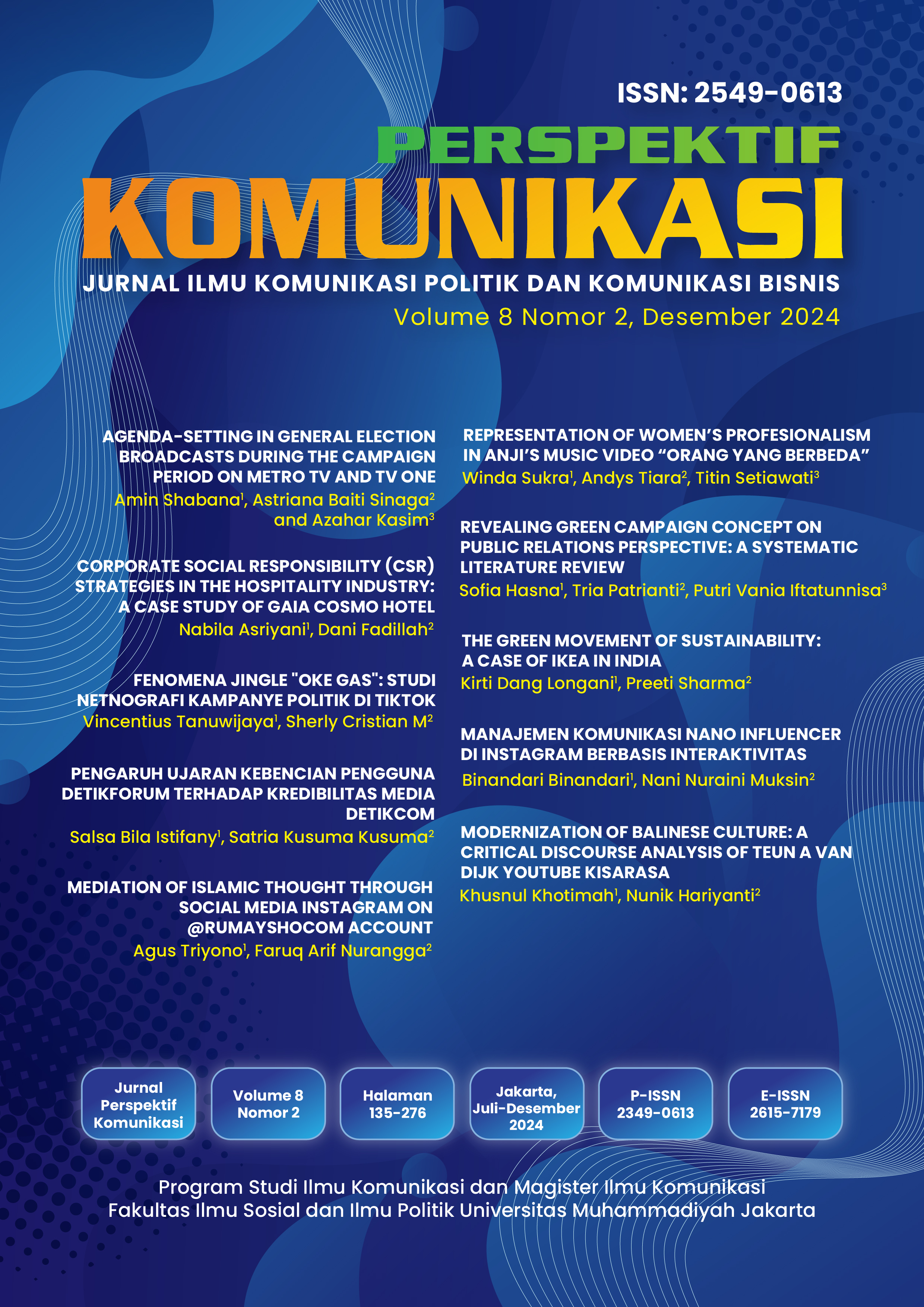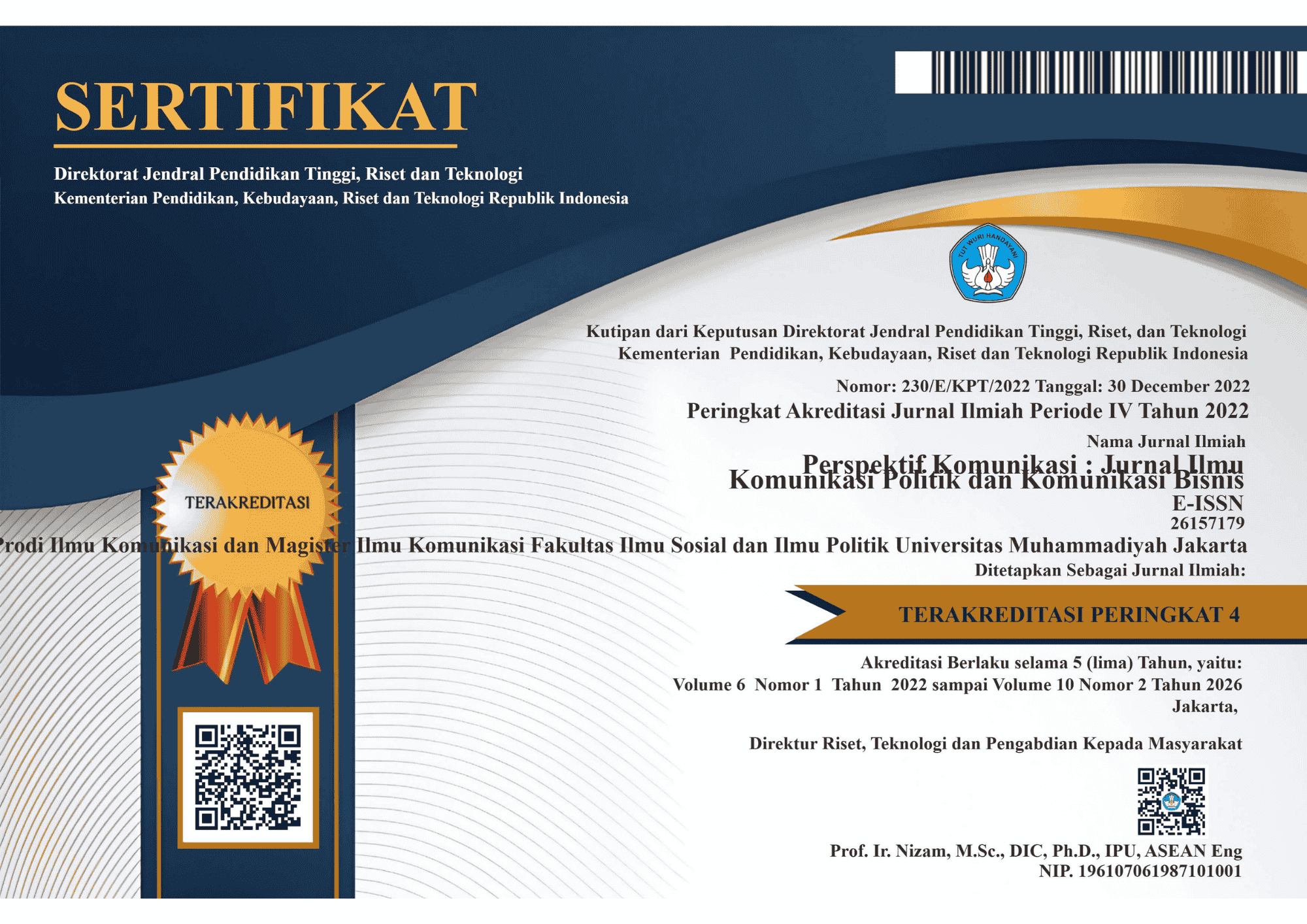REPRESENTATION OF WOMEN’S PROFESIONALISM IN ANJI’S MUSIC VIDEO “ORANG YANG BERBEDA”
DOI:
https://doi.org/10.24853/pk.8.2.213-228Keywords:
Music Video Clips, Representation, Profesionalism, Women.Abstract
The media has a strong influence in shaping people's perceptions and values, but unfortunately the messages conveyed are often not in favor of women. As a reflection of culture, the media often adopts, reinforces and even perpetuates the figure of women with negative connotations through certain roles and attributes that often undermine their abilities, especially in the public sector. Music videos are one form of media that often constructs women unfairly and undignified, to the point of being unprofessional on screen. This paper focuses on the controversial music video clip “Orang Yang Berbeda” by Anji, which is the locus of the author. The purpose of this writing is to try to uncover how the construction of women's professionalism is portrayed in the media. This writing is important to do as a form of effort in fighting for a fairer and more dignified portrayal and placement of women on screen, especially music videos. This writing seeks to contribute to a more positive and empowering representation of women in the media, which ultimately leads to gender equality. This paper will apply the concepts of Peter L. Berger and Thomas Luckmann's construction theory and De George's elements of professionalism to understand the reimagining of women's professionalism in music videos. This paper will use qualitative content analysis method, constructivism paradigm, and qualitative approach. The analysis will focus on the scenes and symbols in the music video. The results of the author's analysis of this music video show doubts about women's ability to work professionally. 4 out of 5 scenes illustrate how the two female roles, Yolla and Celline marginalize the aspects of professionalism stated by George, namely; professionalism must have strong integrity and not be easily tempted by material things or worldly pleasures and professionalism requires a harmony between thoughts and actions.References
Arafat, Y. G. (2018). Membongkar Isi Pesan Dan Media Dengan Content Analysis Gusti Yasser Arafat UIN Antasari Banjarmasin. Jurnal Alhadrah 17(33): 32–48. https://jurnal.uin-antasari.ac.id.
Berger, P. L., & Thomas, L. (1990). Tafsir Sosial Atas Kenyataan. Jakarta : LP3ES.
Butsi, F. I. (2019). Memahami Pendekatan Positivis, Konstruktivis Dan Kritis Dalam Metode Penelitian Komunikasi Febry. jurnal ilmiah ilmu komunikasi 2(1): 421–27.
Faadhilah, M. S., Aliazzra, M. F., & Tsany, F. A. (2022). Eksploitasi Seksualitas Perempuan Dalam Iklan Shopee Versi Big Sale 11.11 2020.” Jurnal Audiens 3(4): 199–207.
Hamid, F. T., Sunarto, & Rahmiaji, L. R. (2022). Representasi Objektifikasi Perempuan Dalam Film Selesai (Analisis Semiotika Roland Barthes). Interaksi Online 11(1): 1–20. https://ejournal3.undip.ac.id/index.php/interaksi-online/article/view/36607.
Sakina, A. I., & Siti A, D. H. (2019). Menyoroti Budaya Patriarki Di Indonesia. Social Work Jurnal 7(1): 1–129.
Kumalaningtyas, N., & Sadasri, L.M. (2018). Citra Tubuh Positif Perempuan Dalam Iklan Video Digital (Studi Femvertising Pada Iklan Dove Real Beauty) Women’S Positive Body Image on Digital Video Advertisement (Femvertising’S Study on Dove Real Beauty Advertisement Campaign). Jurnal Diakom 1(2): 62–73.
Maghfiorh, S.T., & Hulwaniyah, S. A. (2016). Perempuan dan Politik Dalam Kesetaraan Gender. : 6.
Maharany, F. Z., & Junaidi, A. (2020). Representasi Feminisme Dalam Video Klip ‘Nightmare’ Oleh Halsey. Koneksi 4(2): 338.
Muqsith, M.A. (2022). Determinisme Teknologi dan Ekstensi Manusia. Adalah 6(1): 76–84.
Nandaryani, N. W. (2019). Makna Visual Dalam Video Klip" Seni Budaya Bali". SENADA (Seminar Nasional Desain Dan Arsitektur) 2: 105–11.
Novarisa, G. (2019). Dominasi Patriarki Berbentuk Kekerasan Simbolik Terhadap Perempuan Pada Sinetron. Bricolage : Jurnal Magister Ilmu Komunikasi 5(02): 195.
Rusandi, & Rusli, M. (2021). Merancang Penelitian Kualitatif Dasar/Deskriptif Dan Studi Kasus. Al-Ubudiyah: Jurnal Pendidikan dan Studi Islam 2(1): 48–60.
Sujatmoko, M. R., & Widagdo, M. B. (2019). Representasi Kekuasaan Perempuan Dalam Film the Incredibles 2. Interaksi Online 7(3): 183–90. https://ejournal3.undip.ac.id/index.php/interaksi-online/article/view/24169.
Suwinardi. (2017). Profesionalisme Dalam Bekerja. Orbith 13(2): 81–85.
Tresia, T., Yanto, & Bayu, R. (2024). Analisis Konten Edukasi Kesehatan Mental Di Instagram (Analisis Isi Kualitatif Pada Akun Instagram @Studiodjiwa). Jurnal Multidisiplin Dehasen (MUDE) 3(3): 217–22.
Viqri, M. (2023). Representasi Objektifikasi Tubuh Perempuan Dalam Video Klip (Analisis Semiotika John Fiske Pada Video Klip (G)I-DLE – Nxde, Stellar – Marionette Dan AOA – Miniskirt1. Nusantara: Jurnal Ilmu Pengetahuan Sosial 9(4): 1483–90.
Wahidmurni. (2017). Pemaparan Metode Penelitian Kualitatif. 11(1): 92–105.
Widodo, W. R. S. M., Nurudin, & Yutanti, W. (2021). Kesetaraan Gender Dalam Konstruksi Media Sosial. Jurnal Komunikasi Nusantara 3(1): 44–55.
Wulandari, D. (2020). Perempuan Dalam Konstruksi Pemberitaan Bencana. Jurnal Ilmiah Komunikasi 2(2): 183–93. https://sinta.kemdikbud.go.id/journals/profile/8471.



_2.png)


1.png)

2.png)



















